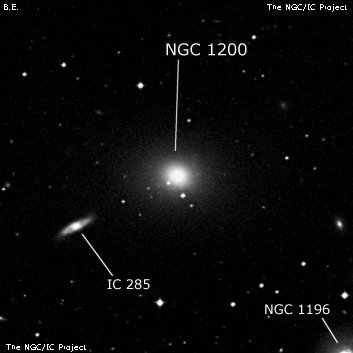
NGC 1200 forms a close pair with IC 285 3.2' ESE. The IC companion was logged as "very faint, small, elongated 5:2 WNW-ESE, very low even surface brightness."
William Herschel discovered NGC 1200 = H II-475 = h2506 on 27 Nov 1785 (sweep 478) and noted "pF, pL, irr F, bM." John Herschel observed this galaxy from the Cape on 22 Nov 1835 and logged "pB, L, R, 80". The N.f. of two, distance about 7.5'; position 45 degrees." His mean position from 2 measures is accurate.
While observing NGC 1200 on 7 Dec 1885 with the Great Melbourne Telescope, Pietro Baracchi discovered nearby IC 285 and made an independent discovery of NGC 1195 (found earlier by Dreyer).
400/500mm - 17.5" (10/20/90): fairly faint, fairly small, round, bright core, halo slightly elongated N-S. There is an extremely faint star or possible companion at the south edge. Third of four and brightest in a compact quartet with NGC 1195 and 1196.
600/800mm - 24" (12/6/18): at 375x; fairly bright, fairly large, slightly elongated but orientation difficult to pin down. The brighter central region is strongly concentrated with a very small brighter nucleus. The outer 1' halo has a very low surface brightness and drops off imperceptibly into the background sky. A mag 15.4 star is at the south edge of the halo. Brightest in a quartet with IC 285 3' SE and brightest in the larger USGC S110 galaxy group (9 members).
Notes by Steve Gottlieb